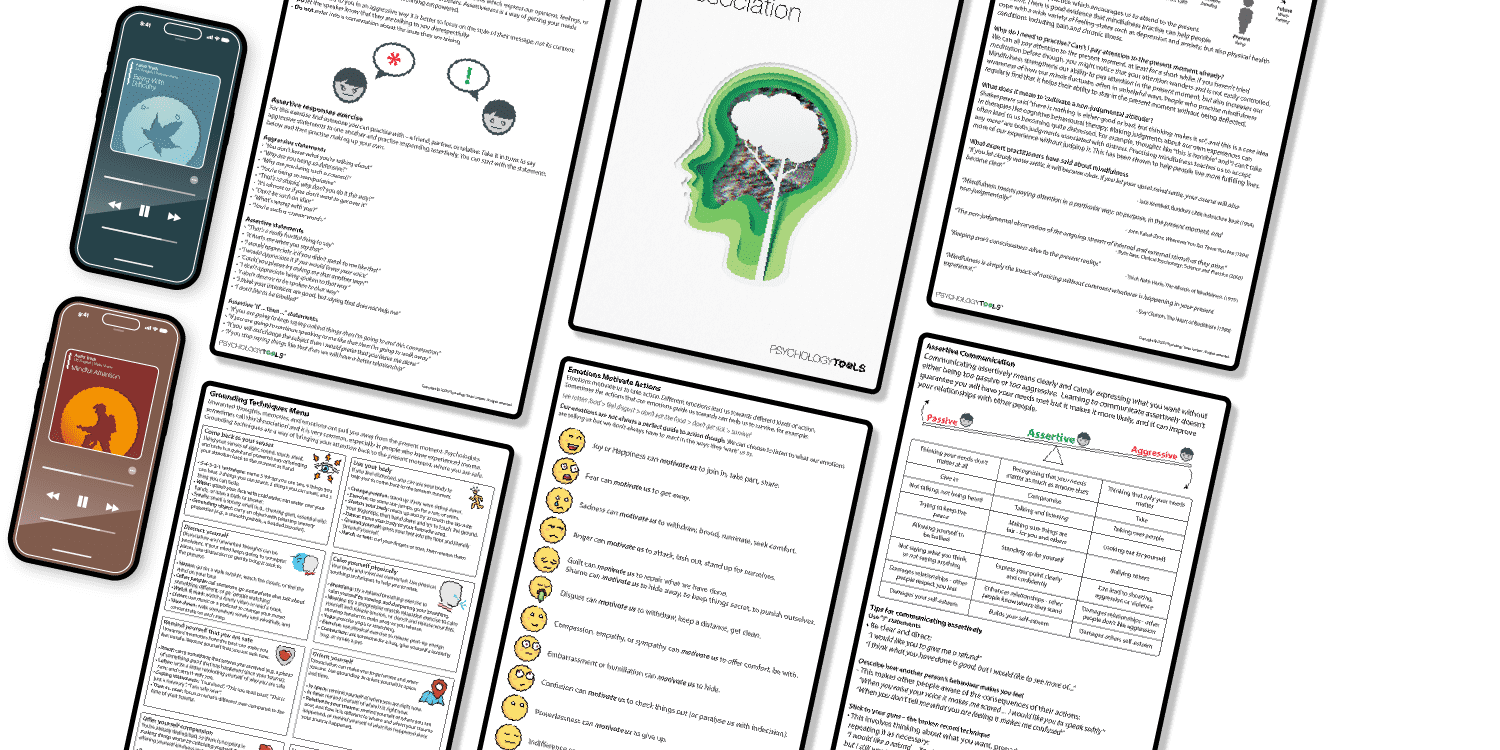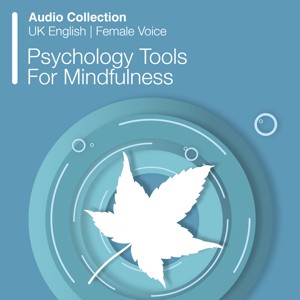Dialectical Behavior Therapy (DBT)
Dialectical Behavior Therapy (DBT) is part of the cognitive-behavioral family of therapies. It was originally developed to treat seriously and chronically suicidal patients and has evolved to treat patients who meet criteria for borderline personality disorder and problems of emotional regulation. DBT combines principles of behavioral psychology, which are used to promote change, with mindfulness principles adapted from Buddhism, which are used to promote acceptance (Linehan, 1993). Read more

18 of 18 resources
Grounding Techniques Menu
Dissociation can be described as a shift of a person’s attention away from the present moment. When working with traumatized clients, this shift oft ...
https://www.psychologytools.com/resource/grounding-techniques-menu/
Assertive Communication
Communicating and acting assertively is an interpersonal skill that helps people to maintain healthy relationships, resolve interpersonal conflict, an ...
https://www.psychologytools.com/resource/assertive-communication/
Grounding Techniques
Individuals who have experienced trama often find it difficult to stay within the 'window of tolerance'. Grounding techniques (which can be sensory/pe ...
https://www.psychologytools.com/resource/grounding-techniques/
Assertive Responses
Being able to communicate assertively is an essential skill for developing and maintaining healthy relationships and positive self-esteem. Individuals ...
https://www.psychologytools.com/resource/assertive-responses/
Emotions Motivate Actions
Many clients find it helpful to recognize the range of actions that are motivated by different emotional states. This worksheet encourages clients to ...
https://www.psychologytools.com/resource/emotions-motivate-actions/
Audio Collection: Psychology Tools For Mindfulness
The Psychology Tools For Mindfulness Audio Collection is the perfect way to introduce your clients to the practice of mindfulness. Developed by a clin ...
https://www.psychologytools.com/resource/psychology-tools-for-mindfulness-audio-collection/
What Is Mindfulness?
Mindfulness meditation is a traditional Buddhist practice. It is now commonly taught as a practice helpful in the management of a variety of mental he ...
https://www.psychologytools.com/resource/what-is-mindfulness/
Problem Solving
Problem Solving is a structured worksheet which encourages solution-focused thinking. Clients are encouraged to identify a problem, identify multiple ...
https://www.psychologytools.com/resource/problem-solving/
Body Scan (Audio)
The Body Scan is a mindfulness exercise encouraging present-moment awareness, with the sensations of the body being used as an anchor for mindful atte ...
https://www.psychologytools.com/resource/body-scan-audio/
Trauma, Dissociation, And Grounding (Archived)
NOTE: An improved version of this resource is available here: Trauma And Dissociation. Older versions of a resource may be archived in the event that ...
https://www.psychologytools.com/resource/trauma-dissociation-and-grounding/
Mindfulness Of Breath (Short Version) (Audio)
Mindfulness Of Breath (Short version) is a mindfulness exercise encouraging present-moment awareness, using the breath as an anchor for the attention. ...
https://www.psychologytools.com/resource/mindfulness-of-breath-short-version-audio/
Being With Difficulty (Audio)
Being With Difficulty is a mindfulness exercise which gently brings present-moment awareness to bear upon thoughts and feelings that are more difficul ...
https://www.psychologytools.com/resource/being-with-difficulty-audio/
Mindfulness In Everyday Life (Audio)
Mindfulness In Everyday Life is a short mindfulness exercise which guides clients how to bring present-moment awareness into everyday life. This audio ...
https://www.psychologytools.com/resource/mindfulness-in-everyday-life-audio/
Mindfulness Of Breath (Long Version) (Audio)
Mindfulness Of Breath (Long version) is a mindfulness exercise encouraging present-moment awareness, using the breath as an anchor for the attention. ...
https://www.psychologytools.com/resource/mindfulness-of-breath-long-version-audio/
Mindfulness Of Sounds And Thoughts (Audio)
Mindfulness Of Sounds And Thoughts is a mindfulness practice exercise that encourages relating to thoughts as ‘just thoughts’ that come and go in ...
https://www.psychologytools.com/resource/mindfulness-of-sounds-and-thoughts-audio/
Mindful Attention (Audio)
The Mindful Attention exercise is an audio track from the Psychology Tools For Overcoming PTSD Audio Collection. This audio track was originally recor ...
https://www.psychologytools.com/resource/mindful-attention-audio/
Thinking Versus Sensing (Audio)
Thinking Versus Sensing is a short mindfulness exercise to demonstrate the difference between thinking about our experience and sensing it directly. E ...
https://www.psychologytools.com/resource/thinking-versus-sensing-audio/
Raisin Exercise (Audio)
The Raisin Exercise is a short mindfulness exercise encouraging present-moment awareness of the senses, connecting with taste, touch and smell while y ...
https://www.psychologytools.com/resource/raisin-exercise-audio/
Links to external resources
Psychology Tools makes every effort to check external links and review their content. However, we are not responsible for the quality or content of external links and cannot guarantee that these links will work all of the time.
Assessment
-
Reasons for Living Scale
| Linehan | 1996
- Scale (Long Form)
- Scale (Short Form)
- Scoring
-
Borderline Symptom List 23 (BSL-23)
| Bohus, Kleindienst, Limberger, Stieglitz, Domsalla, Chapman, Steil, Philipsen, Wolf | 2009
- Scale
- Reference Bohus, M., Limberger, M. F., Frank, U., Chapman, A. L., Kühler, T., & Stieglitz, R.-D. (2007). Psychometric properties of the Borderline Symptom List (BSL). Psychopathology, 40(2), 126–132. https://doi.org/10.1159/000098493
Case Conceptualization / Case Formulation
- DBT Case Formulation Format | Comtois
Guides and workbooks
-
DBT Training
| Christina B. Carter
- DBT Part 1
- DBT Part 2: Behavioral skills
- DBT Part 3: Core Mindfulness
- Self-validation skills for use in DBT group skills training | Fruzetti | 2013
Information Handouts
- DBT skills training pros & cons worksheet
- DEAR MAN GIVE FAST handout & worksheet
- DBT behavior chain & solution analysis worksheet (fillable)
- DBT target behavior chain analysis worksheet archive.org
- Working with primary and secondary emotions worksheet and handout
- Opposite action handout & worksheet
- Check the facts handout & worksheet
- Emotion myths worksheet
- Distress tolerance worksheet
- Guided mindfulness script for practicing mindfulness to emotion
- DBT multi-purpose pros & cons worksheet
- Reality acceptance skills overview
- 6 levels of validation handout & worksheets | Rachel Gill | 2013
- States of mind handout
- DBT skills quick reference sheet
Information (Professional)
- Nightmare protocol | Lineman
Presentations
- The chain analysis in dialectical behavior therapy | Henry Schmidt III | 2012
Treatment Guide
- Dialectical Behaviour Therapy: Skills Handbook | Fulton State Hospital | 2004
- Turning Point: Dialectical Behavior Therapy Program (DBT) – Youth & Coaches Workbook
- Modified DBT group therapy manual for working with adolsecents experiencing substance misuse | Mission Australia
Websites
-
DBTselfhelp.com
- Mindfulness
- Distress Tolerance
- Emotion Regulation
- Interpersonal Effectiveness
- Miscellaneous
Recommended Reading
- Valentine, S. E., Bankoff, S. M., Poulin, R. M., Reidler, E. B., & Pantalone, D. W. (2015). The use of dialectical behavior therapy skills training as stand‐alone treatment: A systematic review of the treatment outcome literature.Journal of Clinical Psychology,71(1), 1-20.
- Palmer, R. L. (2002). Dialectical behaviour therapy for borderline personality disorder. Advances in Psychiatric Treatment, 8, 10-16
- Linehan, M. M., & Wilks, C. R. (2015). The course and evolution of dialectical behavior therapy.American journal of psychotherapy,69(2), 97-110.
What Is Dialectical Behavior Therapy?
The Purpose of DBT
Linehan (2015a, 2015b) describes the purpose or functions of DBT as:
- to enhance an individual’s capability by increasing skillful behavior;
- to improve and maintain the client’s motivation to change and to engage with treatment;
- to ensure that generalization of change occurs through treatment;
- to enhance a therapist’s motivation to deliver effective treatment;
- to assist the individual in restructuring or changing her environment in ways that support and maintain progress and movement toward goals.
DBT Skills Training
DBT teaches a balance of ‘acceptance skills’ and ‘change skills.’ These include:
- Mindfulness skills (acceptance) including core mindfulness skills (nonjudgmental observation) and more complex mindfulness practice (wise mind, loving kindness, balancing ‘doing’ and ‘being’).
- Distress tolerance skills (acceptance) including crisis survival skills, reality acceptance skills, and distress tolerance skills related to addiction.
- Emotion regulation skills (change) including recognizing emotions, changing emotional responses (including cognitive restructuring), and reducing vulnerability to the emotional mind.
- Interpersonal effectiveness skills (change) including objectives, relationship, and self-respect effectiveness skills.
Treatment Strategies in DBT
Treatment strategies in DBT include:
- Dialectical strategies in which attention is paid toward balancing acceptance and change. Techniques include the use of metaphor and paradox, cognitive challenging, and restructuring.
- Core strategies include problem solving and validation. Problem solving involves analysis and acceptance of a problem followed by an attempt to generate, evaluate, and implement adaptive solutions. Chain analysis is frequently used to analyze problem behaviors in the context of chains of actions, emotions, physiological responses, and cognitions. Skillful (wise) responses are generated and practiced.
- Communication strategies are closely attended to in DBT. DBT therapists balance reciprocal communication that responds to the client’s agenda with an irreverent communication style intended to promote insight and change.
- Case management strategies are used in DBT to guide the therapist’s interactions, including regular supervision and consultation on the grounds that complex clients should not be treated/‘held’ by a sole clinician.
References
- Linehan, M. M. (1993). Cognitive–behavioral therapy of borderline personality disorder. New York: Guilford Press.
- Linehan, M. M. (2015a). DBT skills training handouts and worksheets(2nd ed.). New York: Guilford Press.
- Linehan, M. M. (2015b). DBT skills training manual(2nd ed.). New York: Guilford Press.

















